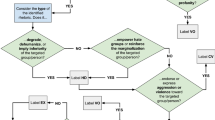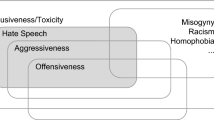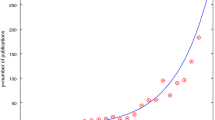Abstract
This preliminary chapter is part of the Introduction to the book, “Online Hate Speech: Object, Approaches, Issues”, and it has a threefold purpose. First, it outlines the general theoretical framework of the volume by offering an overview of the most relevant linguistic approaches to hate speech to date. Then, it describes the genesis of the book, which stems from a four-year research project, netlang, by reporting on the construction and pre-processing of its online hate speech corpus, to which half the chapters resort in their analyses. Finally, it presents the collection by explaining the book’s design and layout, namely the three parts into which it is organised, and by introducing the internal and external contributions which integrate each of them, respectively by members of the project and by participants in its final conference.
Access this chapter
Tax calculation will be finalised at checkout
Purchases are for personal use only
Similar content being viewed by others
Notes
- 1.
Funded by the Portuguese Foundation for Science and Technology, the NETLANG project integrated linguists from five different European countries: besides Portugal, Czech Republic, Estonia, Finland, and Poland. It also integrated researchers from other areas besides linguistics: computer scientists, psychologists, law and education scholars. The project’s full title, which bears the initial adoption of a term (“cyberbullying”) which later came to be overshadowed and definitely replaced by “hate speech”, is “The Language of Cyberbullying: Forms and Mechanisms of Online Prejudice and Discrimination in Annotated Comparable Corpora of Portuguese and English” (ref. PTDC/LLT-LIN/29304/2017).
- 2.
References
Anderson, L., & Lepore, E. (2013). Slurring words. Noûs, 47(1), 25–48.
Argueta, C., Calderon, F. H., & Chen, Y.-S. (2016). Multilingual emotion classifier using unsupervised pattern extraction from microblog data. Intelligent Data Analysis, 20, 1477–1502.
Assimakopoulos, S. (2020). Incitement to discriminatory hatred, illocution and perlocution. Pragmatics and Society, 11(2), 177–195.
Assimakopoulos, S., Muskat, R. V., Van Der Plas, L., & Gatt, A. (2020). Annotating for hate speech: The MaNeCo corpus and some input from critical discourse analysis. arXiv preprint arXiv:2008.06222.
Baccianella, S., Esuli, A., & Sebastiani, F. (2010). SentiWordNet 3.0: An enhanced lexical resource for sentiment analysis and opinion mining. In Proceedings of the seventh international conference on language resources and evaluation (LREC’10). European Language Resources Association (ELRA).
Badlani, R., Asnani, N., & Rai, M. (2019). Disambiguating sentiment: An ensemble of humour, sarcasm, and hate speech features for sentiment classification. W-NUT, 2019, 337–345.
Banks, J. (2010). Regulating hate speech online. International Review of Law, Computers & Technology, 24(3), 233–239.
Baumgarten, N., Bick, E., Geyer, K., Iversen, D. A., Kleene, A., Lindø, A. V., Neitsch, J., Niebuhr, O., Nielsen, R., & Petersen, E. N. (2019). Towards balance and boundaries in public discourse: Expressing and perceiving online hate speech (XPEROHS). In J. Mey, J. A. Holsting, & C. Johannessen (Eds.), RASK – International Journal of Language and Communication (Vol. 50, pp. 87–108). University of Southern Denmark.
Beliaeva, N. (2022). Is play on words fair play or dirty play? On ill-meaning use of morphological blending. In N. Knoblock (Ed.), The Grammar of Hate (pp. 177–196). Cambridge University Press.
Benesch, S. (2014). Defining and diminishing hate speech. State of the World’s Minorities and Indigenous Peoples, 18–25.
Bianchi, R. (2022). ‘Kill the invaders’: Imperative verbs and their grammatical patients in Tarrant’s the great replacement. In N. Knoblock (Ed.), The Grammar of Hate (pp. 222–240). Cambridge University Press.
Brindle, A. (2016). The Language of Hate: A Corpus Linguistic Analysis of White Supremacist Language. Routledge.
Burgess, R. (2018). Key Variables in Social Investigation. Routledge.
Burke, S., Diba, P., & Antonopoulos, G. A. (2020). ‘You sick, twisted messes’: The use of argument and reasoning in Islamophobic and anti-Semitic discussions on Facebook. Discourse and Society, 31(4), 374–389.
Butler, J. (1997). Excitable Speech: A Politics of the Performative. Routledge.
Carney, T. (2014). Being (im)polite: A forensic linguistic approach to interpreting a hate speech case. Language Matters, 45(3), 325–341.
Carr, C. T., & Hayes, R. A. (2015). Social media: Defining, developing, and divining. Atlantic Journal of Communication, 23(1), 46–65.
Carr, C., Robinson, M., & Palmer, A. (2020). Improving hate speech detection precision through an impoliteness annotation scheme. In 94th Annual Meeting of the Linguistic Society of America, New Orleans.
Culpeper, J. (2021). Impoliteness and hate speech: Compare and contrast. Journal of Pragmatics, 179, 4–11.
Culpeper, J., Iganski, P., & Sweiry, A. (2017). Linguistic impoliteness and religiously aggravated hate crime in England and Wales. Journal of Language Aggression and Conflict, 5(1), 1–29.
Dadvar, M., Jong, F., Ordelman, R., & Trieschnigg, D. (2012). Improved cyberbullying detection using gender information. In Proceedings of the 12th Dutch-Belgian information retrieval workshop (pp. 23–25).
Davidson, T., Warmsley, D., Macy, M., & Weber, I. (2017). Automated hate speech detection and the problem of offensive language. Proceedings of the International AAAI Conference on Web and Social Media, 11, 512–515.
Dinakar, K., Reichart, R., & Lieberman, H. (2011). Modeling the detection of textual cyberbullying. Soc. Mobile Web, 11, 02.
Domínguez-Armas, A., Soria-Ruiz, A., & Lewiński, M. (2023). Provocative insinuations as hate speech: Argumentative functions of mentioning ethnicity in headlines. Topoi, 42, 1–13.
Đorđević, J. P. (2019). The sociocognitive dimension of hate speech in readers’ comments on Serbian news websites. Discourse, Context and Media., 33(2020), 1–9.
Ehrlich, S. (2001). Representing Rape: Language and Sexual Consent. Psychology Press.
Ehrlich, S. (2014). Language, gender, and sexual violence. In S. Ehrlich, M. Meyerhoff, & J. Holmes (Eds.), The Handbook of Language, Gender, and Sexuality (2nd ed., pp. 452–470). Wiley.
Elias, C., Gonçalves, J., Araújo, M., Pinheiro, P., Araújo, C., & Henriques, P. (2021). NetAC, an automatic classifier of online hate speech comments. In A. Rocha, H. Adeli, G. Dzemyda, F. Moreira, & A. M. Ramalho Correia (Eds.), Trends and Applications in Information Systems and Technologies (pp. 494–505). Springer.
Ermida, I. (2014). A beached whale posing in lingerie: Conflict talk, disagreement and impoliteness in online newspaper commentary. Diacrítica, 27(1), 95–130.
Ermida, I. (2018). ‘Get the snip – And a job!’ Disagreement, impoliteness, and conflicting identities on the internet. Token: A Journal of English Linguistics, 6, 205–247.
Ermida, I., Pereira, F. & Dias, I. (2023). Social media mining for hate speech detection: Opinion and emotion conflict in adversative constructions. Forthcoming.
Esposito, E., & Zollo, S. A. (2021). “How dare you call her a pig! I know several pigs who would be upset if they knew”: A multimodal critical discursive approach to online misogyny against UK MPs on YouTube. Journal of Language Aggression and Conflict, 9(1), 47–75.
European Commission. (2021). Ethics and Data Protection. Guidance note by DG Research and Innovation. Retrieved from https://ec.europa.eu
Fersini, E., Nozza, D., & Rosso, P. (2018). Overview of the evalita 2018 task on automatic misogyny identification (AMI). In EVALITA – Evaluation of NLP and Speech Tools for Italian: Proceedings of the Final Workshop, pp. 59–66.
Gehl, R. W. (2016). Power/freedom on the dark web: A digital ethnography of the dark web social network. New Media & Society, 18(7), 1219–1235.
Gelber, K. (2017). Hate speech definitions & empirical evidence. Constitutional Commentary, 32, 619–629.
Geyer, K., Bick, E., & Kleene, A. (2022). ‘I am no racist but...’: A corpus-based analysis of xenophobic hate speech constructions in Danish and German social media discourse. In E. Knoblock (Ed.), The Grammar of Hate (pp. 241–261). Cambridge University Press.
Gilbert, O., Pérez, N., García-Pablos, A., & Cuadros, M. (2018). Hate speech dataset from a white supremacy forum. In Proceedings of the 2nd Workshop on Abusive Language Online (pp. 11–20). Association for Computational Linguistics.
Gitari, N. D., Zuping, Z., Damien, H., & Long, J. (2015). A lexicon-based approach for hate speech detection. International Journal of Multimedia and Ubiquitous Engineering, 10, 215–230.
Godioli, A., Young, J., & Fiori, B. M. (2022). Laughing matters: Humor, free speech and hate speech at the European court of human rights. International Journal for the Semiotics of Law/Revue internationale de Sémiotique juridique, 35, 1–25.
Hardaker, C., & McGlashan, M. (2016). ‘Real men don’t hate women’: Twitter rape threats and group identity. Journal of Pragmatics, 91, 80–93.
Hart, C. (2010). Critical Discourse Analysis and Cognitive Science: New Perspectives on Immigration Discourse. Palgrave Macmillan.
Hedger, J. A. (2013). Meaning and racial slurs: Derogatory epithets and the semantics /pragmatics interface. Language & Communication, 33(3), 205–213.
Henriques, P., Araújo, C., Ermida, I., & Dias, I. (2019). Scraping news sites and social networks for prejudice term analysis. In H. Weghorn & L. Rodrigues (Eds.), Proceedings of the 16th International Conference on Applied Computing 2019 (pp. 179–189).
Hornsby, J. (1995). Speech acts and pornography. In S. Dwyer (Ed.), The Problem of Pornography. Wadsworth Publishing Company, Springer.
Hutto, C., & Gilbert, E. (2014). VADER: A parsimonious rule-based model for sentiment analysis of social media text. Proceedings of the International AAAI Conference on Web and Social Media, 8, 216–225.
Kazienko, P., Bielaniewicz, J., Gruza, M., Kanclerz, K., Karanowski, K., Miłkowski, P., & Kocoń, J. (2023). Human-centred neural reasoning for subjective content processing: Hate speech, emotions, and humor. Information Fusion, 94, 43–65.
Kienpointner, M. (2018). Impoliteness online: Hate speech in online interactions. Internet Pragmatics, 1(2), 329–351.
Knoblock, N. (Ed.). (2022). The Grammar of Hate: Morphosyntactic Features of Hateful, Aggressive, and Dehumanizing Discourse. Cambridge University Press.
Konikoff, D. (2021). Gatekeepers of toxicity: Reconceptualizing Twitter’s abuse and hate speech policies. Policy & Internet, 13(4), 502–521.
Korecky-Kröll, K., & Dressler, W. (2022). Expressive German adjective and noun compounds in aggressive discourse. In N. Knoblock (Ed.), The Grammar of Hate (p. 197). Cambridge University Press.
Lange, P. G. (2014). Commenting on YouTube rants: Perceptions of inappropriateness or civic engagement? Journal of Pragmatics, 73, 53–65.
Langton, R. (1993). Speech acts and unspeakable acts. Philosophy and Public Affairs, 22(4), 293–330.
Langton, R. (2018). The authority of hate speech. Oxford Studies in Philosophy of Law, 3, 123–152.
Lederer, L. J., & Delgado, R. (Eds.). (1995). The Price We Pay: The Case against Racist Speech, Hate Propaganda, and Pornography. Hill & Wang.
Leskova, A. (2016). “Black Humor” in Modern Europe: Freedom of Speech v. Racist Hate Speech. Or Where is the Line for Racist Humor? Doctoral dissertation, University of Sevilla.
Lewis, M. (2012). A Cognitive Linguistics Overview of Offense and Hate Speech. Available at SSRN 2205178.
Lind, M., & Nübling, D. (2022). The neutering neuter. The discursive use of German grammatical gender in dehumanisation. In N. Knoblock (Ed.), The Grammar of Hate (pp. 118–139). Cambridge University Press.
Liu, S., & Forss, T. (2015). New classification models for detecting hate and violence web content. In Proceedings of the 7th International Joint Conference on Knowledge Discovery, Knowledge Engineering and Knowledge Management (IC3K’15) (Vol. 1, pp. 487–495). IEEE.
Ljubešić, N., Fišer, D., & Erjavec, T. (2019). The FRENK datasets of socially unacceptable discourse in Slovene and English. In Proceedings of 22nd International Conference on Text, Speech, and Dialogue, TSD 2019 (pp. 103–114). Springer.
Lorenzo-Dus, N., Blitvich, P. G.-C., & Bou-Franch, P. (2011). On-line polylogues and impoliteness: The case of postings sent in response to the Obama Reggaeton YouTube video. Journal of Pragmatics, 43, 2578–2593.
MacAvaney, S., Yao, H. R., Yang, E., Russell, K., Goharian, N., & Frieder, O. (2019). Hate speech detection: Challenges and solutions. PLoS One, 14(8), e0221152.
Macdonald, S., & Lorenzo-Dus, N. (2020). Intentional and performative persuasion: The linguistic basis for criminalizing the (direct and indirect) encouragement of terrorism. Criminal Law Forum, 31(4), 473–512.
MacKinnon, C. A. (1993). Only Words. Harvard University Press.
Matsuda, M. J., Lawrence, C. L., Delgado, R., & Crenshaw, K. W. (1993). Words that Wound: Critical Race Theory, Assaultive Speech, and the First Amendment. Westview Press.
Mattiello, E. (2022). Language aggression in English slang: The case of the-o suffix. In N. Knoblock (Ed.), The Grammar of Hate (pp. 34–58). Cambridge University Press.
Menon, P. (2022). Laughter is the Best Poison: Antagonistic Humor as the Handmaiden of Hate Speech. University of Michigan – Ann Arbor.
Musolff, A. (2017). Dehumanizing metaphors in UK immigrant debates in press and online media. Journal of Language Aggression and Conflict, 3(1), 41–56.
Nagle, J. C. (2009). The idea of pollution. UC Davis Law Review, 43(1), 1–78.
Nobata, C., Tetreault, J., Thomas, A., Mehdad, Y., & Chang, Y. (2016). Abusive language detection in online user content. In Proceedings of the 25th International Conference on World Wide Web, 145–153.
Nunberg, G. (2018). The social life of slurs. In D. Fogal, D. Harris, & M. Moss (Eds.), New work on Speech Acts (pp. 237–295). Oxford University Press.
O’Driscoll, J. (2020). Offensive Language: Taboo, Offence and Social Control. Bloomsbury.
Ohlson, L. F. (2022). The power of a pronoun. In N. Knoblock (Ed.), The Grammar of Hate (pp. 161–176). Cambridge University Press.
Özarslan, Z. (2014). Introducing two new terms into the literature of hate speech, “hate discourse” and “hate speech act”: Application of speech act theory to hate speech studies in the era of web 2.0. Galatasaray Üniversitesi İletişim Dergisi, 20, 53–75.
Pettersson, K., & Sakki, I. (2023). ‘You truly are the worst kind of racist!’: Argumentation and polarization in online discussions around gender and radical-right populism. British Journal of Social Psychology, 62(1), 119–135.
Prażmo, E. (2020). Foids are worse than animals. A cognitive linguistics analysis of dehumanizing metaphors in online discourse. Topics in Linguistics, 21(2), 16–27.
Raffone, A. (2022). “Her leg didn’t fully load in”: A digitally-mediated social-semiotic critical discourse analysis of disability hate speech on TikTok. International Journal of Language Studies, 16(4), 17–42.
Raj, S. M., & Usman, A. (2021). The use of mental spaces in the conceptualization of hate speech. GPH - International Journal of Social Science and Humanities Research, 4(05), 12–21.
Ross, B., Rist, M., Carbonell, G., Cabrera, B., Kurowsky, N., & Wojatzki, M. (2016). Measuring the reliability of hate speech annotations: The case of the European refugee crisis. In The 3rd Workshop on Natural Language Processing for Computer-Mediated Communication.
Schmidt, A., & Wiegand, M. (2017). A survey on hate speech detection using natural language processing. In Proceedings of the Fifth International Workshop on Natural Language Processing for Social Media of the Valencia Association for Computational Linguistics, 1–10.
Schwartzman, L. H. (2002). Hate speech, illocution, and social context: A critique of Judith Butler. Journal of Social Philosophy, 33(3), 421–441.
Scott, M. (2010). Problems in investigating keyness, or clearing the undergrowth and marking out trails…. In M. Bondi & M. Scott (Eds.), Keyness in Texts (pp. 43–58). John Benjamins.
Sharifi, M., Ansari, N., & Asadollahzadeh, M. (2017). A critical discourse analytic approach to the discursive construction of Islam in Western talk shows: The case of CNN talk shows. International Communication Gazette, 79(1), 45–63.
Silva, L. A., Mondal, M., Correa, D., Benevenuto, F., & Weber, I. (2016). Analyzing the targets of hate in online social media. ICWSM, 687–690.
Sirulhaq, A., Yuwono, U., & Muta’ali, A. (2023). Why do we need a sociocognitive-CDA in hate speech studies? A corpus-based systematic review. Discourse & Society. https://doi.org/10.1177/0957926522112659
Soffer, O. (2010). “Silent orality”: Toward a conceptualization of the digital oral features in CMC and SMS texts. Communication Theory, 20(4), 387–404.
Stokoe, E., & Edwards, D. (2007). ‘Black this, black that’: Racial insults and reported speech in neighbour complaints and police interrogations. Discourse & Society, 18, 337–372.
Tarasova, E., & Fajardo, J. A. S. (2022). Adj+ie/y nominalizations in contemporary English: From diminution to pejoration. In N. Noblock (Ed.), The Grammar of Hate (pp. 59–73). Cambridge University Press.
Trindade, L. V. P. (2020). Disparagement humour and gendered racism on social media in Brazil. Ethnic and Racial Studies, 43(15), 2766–2784.
Tsesis, A. (2009). Dignity and speech: The regulation of hate speech in a democracy. Wake Forest Law Review, 44, 497–532.
Van Dijk, T. A. (1987). Racism and the Press. Routledge.
Van Dijk, T.A. (2005). Racism and discourse in Spain and Latin America. Benjamins.
Van Dijk, T. A. (2021). Antiracist Discourse. Theory and History of a Macromovement. Cambridge University Press.
Vasilaki, M. (2014). Name-calling in Greek YouTube comments. In C. Pérez-Arredondo, M. Calderón-López, H. Hidalgo-Avilés, & D. Pask-Hughes (Eds.), Papers from the 9th Lancaster University postgraduate conference in Linguistics & Language Teaching (pp. 90–110). Lancaster University.
Warner, W., & Hirschberg, J. (2012). Detecting hate speech on the world wide web. In Proceedings of the Second Workshop on Language in Social Media of the Association for Computational Linguistics, 19–26.
Waseem, Z., & Hovy, D. (2016). Hateful symbols or hateful people? Predictive features for hate speech detection on Twitter. In Proceedings of the NAACL Student Research Workshop, pp 88–93.
Weston, D. A. (2022). When does speech perform regulable action? A critique of speech act theory’s application to free speech regulation. International Journal of Language & Law (JLL), 11, 78–97.
Williamson, T. (2009). Reference, inference and the semantics of pejoratives. In J. In Almog & P. Leonardi (Eds.), The philosophy of David Kaplan (pp. 137–158). Oxford University Press.
Woods, F. A., & Ruscher, J. B. (2021). Viral sticks, virtual stones: Addressing anonymous hate speech online. Patterns of Prejudice, 55(3), 265–289.
Zampieri, M., Malmasi, S., Nakov, P., Rosenthal, S., Farra, N., & Kumar, R. (2019). Semeval-2019 task 6: Identifying and categorizing offensive language in social media (offenseval). arXiv preprint arXiv:1903.08983.
Acknowledgement
This work was sponsored by FCT (Foundation for Science and Technology, Portugal), under the auspices of the NETLANG project, ref. PTDC/LLT-LIN/29304/2017.
Author information
Authors and Affiliations
Corresponding author
Editor information
Editors and Affiliations
Rights and permissions
Copyright information
© 2023 The Author(s), under exclusive license to Springer Nature Switzerland AG
About this chapter
Cite this chapter
Ermida, I. (2023). Building and Analysing an Online Hate Speech Corpus: The NETLANG Experience and Beyond. In: Ermida, I. (eds) Hate Speech in Social Media. Palgrave Macmillan, Cham. https://doi.org/10.1007/978-3-031-38248-2_1
Download citation
DOI: https://doi.org/10.1007/978-3-031-38248-2_1
Published:
Publisher Name: Palgrave Macmillan, Cham
Print ISBN: 978-3-031-38247-5
Online ISBN: 978-3-031-38248-2
eBook Packages: Social SciencesSocial Sciences (R0)




